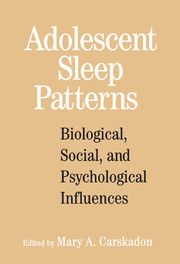Book contents
- Frontmatter
- Contents
- List of Contributors
- Foreword
- Preface
- Adolescent Sleep Patterns
- 1 Sleep and Adolescence: A Social Psychologist's Perspective
- 2 Factors Influencing Sleep Patterns of Adolescents
- 3 Endocrine Changes Associated with Puberty and Adolescence
- 4 Maturational Changes in Sleep-Wake Timing: Longitudinal Studies of the Circadian Activity Rhythm of a Diurnal Rodent
- 5 Nutrition and Circadian Activity Offset in Adolescent Rhesus Monkeys
- 6 Toward a Comparative Developmental Ecology of Human Sleep
- 7 Sleep Patterns of High School Students Living in São Paulo, Brazil
- 8 Sleep Patterns and Daytime Function in Adolescence: An Epidemiological Survey of an Italian High School Student Sample
- 9 Risks of Driving While Sleepy in Adolescents and Young Adults
- 10 What Can the Study of Work Scheduling Tell Us about Adolescent Sleep?
- 11 Accommodating the Sleep Patterns of Adolescents within Current Educational Structures: An Uncharted Path
- 12 Bridging the Gap between Research and Practice: What Will Adolescents' Sleep-Wake Patterns Look Like in the 21st Century?
- 13 Influence of Irregular Sleep Patterns on Waking Behavior
- 14 Stress and Sleep in Adolescence: A Clinical-Developmental Perspective
- 15 The Search for Vulnerability Signatures for Depression in High-Risk Adolescents: Mechanisms and Significance
- 16 The Regulation of Sleep-Arousal, Affect, and Attention in Adolescence: Some Questions and Speculations
- Index
- References
13 - Influence of Irregular Sleep Patterns on Waking Behavior
Published online by Cambridge University Press: 22 September 2009
- Frontmatter
- Contents
- List of Contributors
- Foreword
- Preface
- Adolescent Sleep Patterns
- 1 Sleep and Adolescence: A Social Psychologist's Perspective
- 2 Factors Influencing Sleep Patterns of Adolescents
- 3 Endocrine Changes Associated with Puberty and Adolescence
- 4 Maturational Changes in Sleep-Wake Timing: Longitudinal Studies of the Circadian Activity Rhythm of a Diurnal Rodent
- 5 Nutrition and Circadian Activity Offset in Adolescent Rhesus Monkeys
- 6 Toward a Comparative Developmental Ecology of Human Sleep
- 7 Sleep Patterns of High School Students Living in São Paulo, Brazil
- 8 Sleep Patterns and Daytime Function in Adolescence: An Epidemiological Survey of an Italian High School Student Sample
- 9 Risks of Driving While Sleepy in Adolescents and Young Adults
- 10 What Can the Study of Work Scheduling Tell Us about Adolescent Sleep?
- 11 Accommodating the Sleep Patterns of Adolescents within Current Educational Structures: An Uncharted Path
- 12 Bridging the Gap between Research and Practice: What Will Adolescents' Sleep-Wake Patterns Look Like in the 21st Century?
- 13 Influence of Irregular Sleep Patterns on Waking Behavior
- 14 Stress and Sleep in Adolescence: A Clinical-Developmental Perspective
- 15 The Search for Vulnerability Signatures for Depression in High-Risk Adolescents: Mechanisms and Significance
- 16 The Regulation of Sleep-Arousal, Affect, and Attention in Adolescence: Some Questions and Speculations
- Index
- References
Summary
Two consistent findings in the literature on adolescent sleep patterns are that time spent sleeping on school nights decreases from childhood through adolescence, and that differences between weekend and school-night sleep schedules are large for many teenagers (Billiard, Alperovitch, Perot, & James, 1987; Strauch & Meier, 1988; Carskadon, 1990; Szymczak, Jasinska, Pawlak, & Swierzykowska, 1993). In general, school-night sleep is restricted because of early school start times, whereas on weekends, bedtimes and rise times are later and total sleep time is longer. In a recent large survey of over 3,000 high school students, Wolfson and Carskadon (1998) found such irregular bedtimes related to self-reported academic difficulty in school, daytime sleepiness, depressed mood, and sleep-wake behavior problems. Lower amounts of self-reported total sleep time were also related to more difficulties with daytime functioning. We suspect that these difficulties in daytime function may result in part from disturbances in both the homeostatic and circadian timing systems regulating sleep-wake behavior.
Evidence from other studies in children and adolescents supports the importance of total sleep time and sleep schedule regularity as predictors of daytime functioning. Several other survey studies have linked total sleep time with grades, daytime fatigue and struggles to stay awake, and difficulties concentrating in class (Allen, 1992; Epstein, Chillag, & Lavie, 1995).
- Type
- Chapter
- Information
- Adolescent Sleep PatternsBiological, Social, and Psychological Influences, pp. 220 - 235Publisher: Cambridge University PressPrint publication year: 2002
References
- 24
- Cited by

